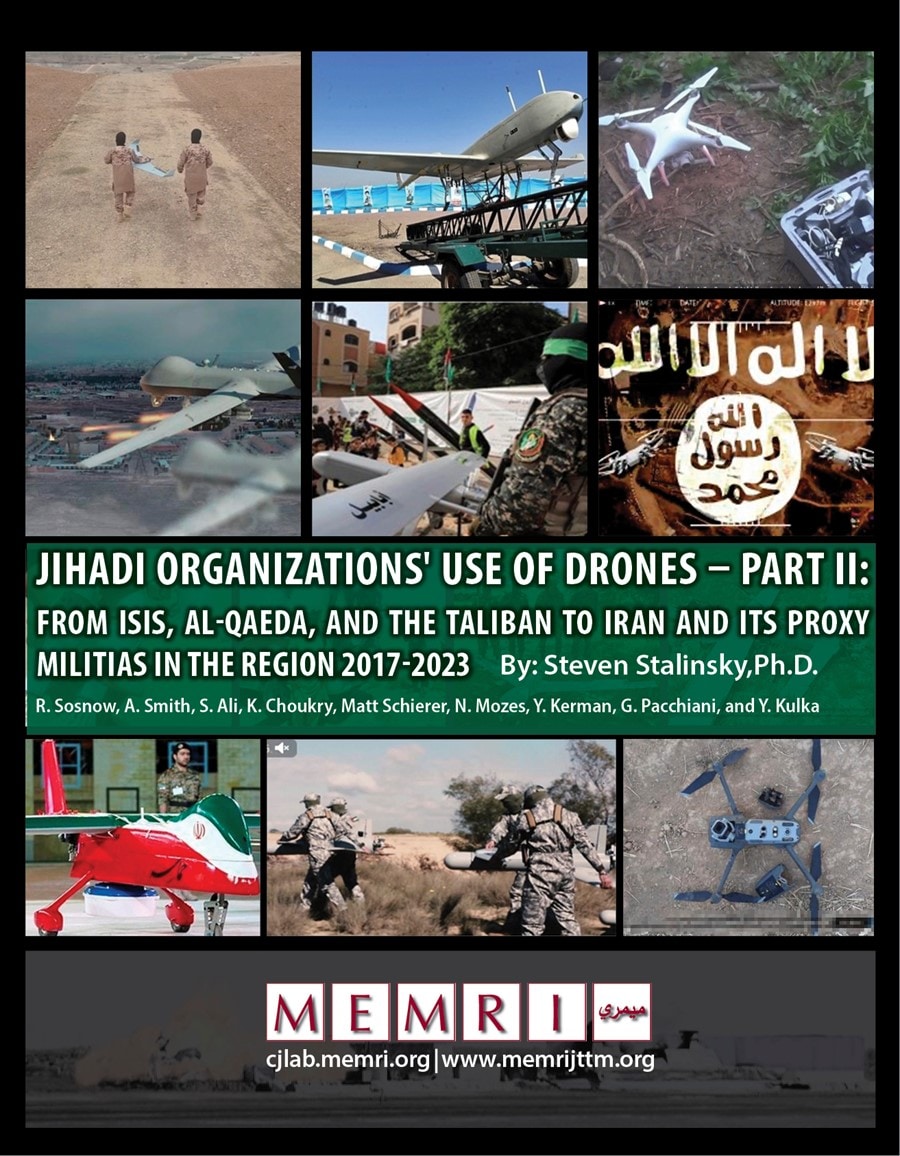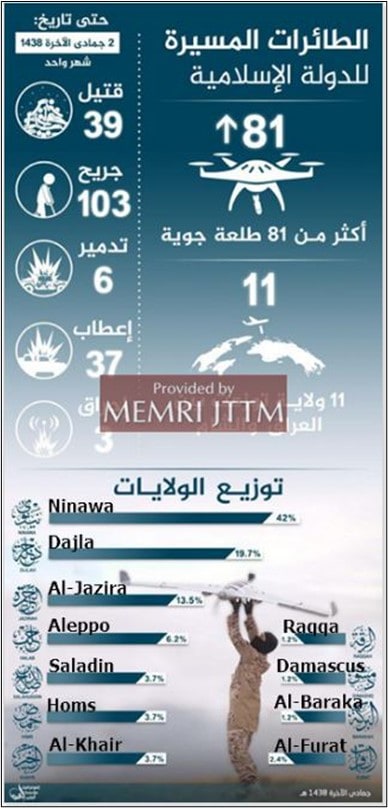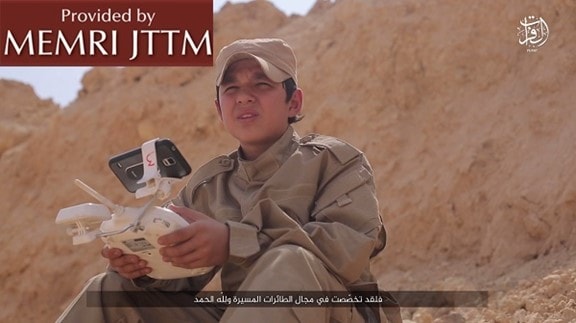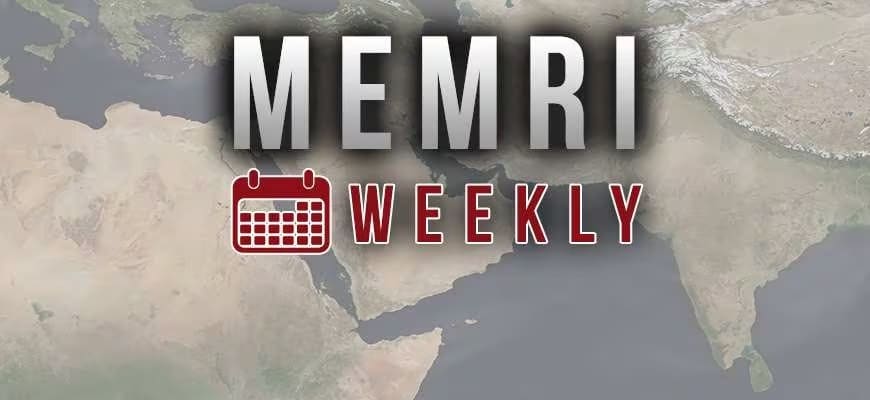Table of Contents
Introduction
I. Use Of Drones By Sunni Jihadi Organizations, Including ISIS, The Taliban, And Al-Qaeda
- ISIS – Improving Technology And Shooting Down Enemy Drones
- Training And Counter-Drone Strategy
- Shooting Down And Capturing Drones
- Drone Technology, Procurement, And Use
- Threats Of Drone Use
- Taliban – Shooting Down Foreign Drones, Using Its Own Against The U.S. And Allies
- Capturing Enemy Drones
- Drone Use Against Adversaries
- Al-Qaeda's Somalia Branch Al Shabab – Capture Of Crashed American Drone And First Reveal Of Their Own Drone
- Capture Of Downed U.S. Drones
- Use Of Drones
- Al-Qaeda In The Arabian Peninsula (AQAP) – Counter-Drone Strategy And Attacks Against Houthis
- Hayat Tahrir Al-Sham (HTS) – Developing Its Own Drones, Shooting Down Foreign Drones
- Counter-Drone Strategy
- Drone Development And Use
- Aspirations To Develop And Acquire Drones
- Shooting Down And Capturing Enemy Drones
- Turkestan Islamic Party (TIP) In Syria – Aerial Filming Of Battle
- Katibat Al-Ghuraba In Syria – Suspected Use Of Camera Drone
- Incite The Believers Operations Room In Syria – Shooting Down Syrian Government Drones
- Miscellaneous Al-Qaeda Supporters – Counter-Drone Strategy And Alleged Use Of Drones
II. Use Of Drones By Iran, Its Islamic Revolutionary Guard Corps (IRGC), And Its Proxy Shi'ite Militias And Terrorist Organizations Across The Region
- Iran And Its IRGC – Expanding Capabilities And Meddling In Regional Conflicts
- Development And Exhibition Of Drone Capabilities
- Hacking American Drones
- Assisting Iranian Proxy Organizations
- IRGC Drones In Syria
- Miscellaneous
- Hizbullah – Evading Israel's Iron Dome, Building Drones Independent Of The IRGC, And Deploying Drones In Syria And Yemen
- Showcasing Technical Capabilities
- Deploying Drones In Syria
- Deploying Drones In Yemen
- Hamas – Drone Attacks, Including On Israeli Gas Platform; Flying Drones Over Israel; Improving Capabilities, And Partnering With Palestinian Islamic Jihad (PIJ)
- Drone Use And Technological Improvements
- Rhetoric And Drone Use Against Israel
- Palestinian Islamic Jihad – Attaching Grenades To Drones
- Drone Capabilities And Use
- Houthis – Drone Use Against The Saudi-Led Coalition With Help From Iranian Proxies
- Showcasing Capabilities
- Downing Foreign Drones
- Use Against Saudi-Led Coalition
- Help From Iran And Its Proxies
- Miscellaneous
- Iraqi Popular Mobilization Units (PMU) – Shooting Down Enemy Drones, Striking Targets Using Drones, And Spying On The U.S. Embassy And Baghdad
- Shooting Down Enemy Drones
- Use Against Americans In Iraq
- Use Against Non-American Enemies
- Relations with Iran And Its Proxies
- Showcasing Capabilities and Threatening Drone Use
- Miscellaneous
- Iranian Drones Used In Russia And Ukraine
Introduction
In 2017, MEMRI released its seminal study, A Decade Of Jihadi Organizations' Use Of Drones – From Early Experiments By Hizbullah, Hamas, And Al-Qaeda To Emerging National Security Crisis For The West As ISIS Launches First Attack Drones. The study outlined various jihadi groups' use of drones for surveillance, reconnaissance, and attack purposes. It painted a picture of a rapidly developing threat to American and coalition forces and allies in the Middle East.

Five years later, the threat of jihadi drone use has grown exponentially. More jihadi groups have gained access to drone technology, and those examined in 2017 have improved upon existing technology and increased its use. For this report, the MEMRI Cyber And Jihad Lab (CJL) and Jihad and Terrorism Threat Monitor (JTTM) research teams built upon the previous report to show the proliferation of the jihadi drone threat – a threat which has garnered attention from U.S. government and military officials. MEMRI JTTM continues to monitor jihadi terror groups discussion and use of drones on a daily basis.
About The MEMRI CJL
The MEMRI CJL monitors, tracks, translates, researches, and analyzes cyber jihad, focusing on technology, cryptocurrency, artificial intelligence, bots, and hacking – and the use of drones for terror purposes – across the Middle East, Iran, South Asia, and North and West Africa. The project innovates and experiments with possible solutions for stopping cyber jihad, advancing legislation and initiatives federally – including with Capitol Hill – and on the state level, to draft and enforce measures that will serve as precedents for further action. It works with leaders in business, law enforcement, and academia.
CENTCOM Head: Drones Are The "Most Concerning Tactical Development" Since The IED
Then-U.S. Central Command (CENTCOM) head Marine Gen. Kenneth McKenzie Jr. told the House Armed Services Committee on April 20, 2021 that the U.S. military was operating without complete air superiority "for the first time since the Korean War" because of the proliferation of small, cheap commercially available drones capable of being outfitted with explosives, and that they are the most "persistent and dangerous" threat to troops in the Middle East in decades and "a new and complex threat to our forces and those of our partners and allies."[1] Earlier, in February 2021, he had called drones "the most concerning tactical development since the rise of the improvised explosive device in Iraq."[2] At that time, CENTCOM had acknowledged that countering drones was its "top priority" but that there was no credible deterrence yet available.[3]

SUPPORT OUR WORK

Outside the U.S., the international community is also concerned about terrorists using drones. United Nations Counter-Terrorism Centre director Dr. Jehangir Khan has emphasized the need for international cooperation and information sharing to combat the potential use of drones by terrorist organizations.[4]
NATO's Integrated Air and Missile Defense Center of Excellence stated: "The rapid increase in the availability and sophistication of UAS, represents a significant challenge, as their capabilities progress faster than the ability to assess and mitigate the threat posed by nefarious small UAS."[5] NATO Officer Claudio Palestini said that "from the military point of view, we are now entering the so-called 'second drone age' in which all competitors, from peers to terrorists and non-state actors, are including drone technologies in their standard tactics and concept of operations, challenging Allies' traditional air superiority in most conflicts. As an example, terrorist groups, like ISIL/Daesh, have been using consumer and recreational UAS to plan, prepare and execute attacks on the battlefield. Also, the Gaza strip recently became one of the most active theatres for modern drone warfare, due to the extensive use of drones both by the Israeli Army and Hamas."[6]
In January 2022, after a drone was shot down approaching Ayn Al-Assad Airbase in Iraq, the International Coalition for Operation Inherent Resolve tweeted: "Attacks are a dangerous distraction from our #AdviseAssistEnable mission and a threat to the Iraqi people. We will continue to defend ourselves and our partners to continue our shared mission to maintain the enduring defeat of Daesh."[7]
The Congressional Research Service stated in a report dated February 9, 2021 underlined the need for "developing effective countermeasures to protect critical infrastructure, including airports and aircraft, from attacks using drones." It also pointed out "the possibility that terrorists could use a drone to carry out an attack against a ground target... to carry out small-scale attacks using explosives, or as platforms for chemical, biological, or radiological attacks."[8]
Sunni Terror Groups – ISIS, Al-Qaeda, And Their Affiliates – Weaponize Consumer Drones
Sunni terrorist groups such as the Islamic State (ISIS) and Al-Qaeda affiliates across the region, including its Somalia branch Al-Shabab, have weaponized consumer drones, such as the DJI Phantom, by arming them with cameras and explosives. These makeshift weapons are low-cost but effective in targeting enemy troops and civilian populations.
After U.S. troops shot down multiple jihadi drones in January 2022, Pentagon spokesman John Kirby noted that we are continuing to see these "threats against our forces in Iraq and Syria by militia groups that are backed by Iran."[9] Jihadi drone attacks accelerated in the wake of the 2020 killing of IRGC Qods Force commander Qassem Soleimani and Popular Mobilization Forces (PMU) Commander Abu Mahdi Al-Muhandis in a U.S. drone strike.
Iran Manufactures Drones, Provides Them To Its Proxy Shi'ite Militias Across The Region
As the 2017 MEMRI study detailed, Iran was experimenting with drones as early as 2009, when it was reported that Iran-backed Iraqi militants had hacked into video feeds of American Predator and Shadow drones.[10] In January 2012, Al-Manar TV, the channel of the Iran-backed Hizbullah in Lebanon, was already reporting on drone activity in the region.[11] Also covered in the study was Iran's provision of drones to Hizbullah as well as to Hamas in the Gaza Strip.
Iran-backed Shi'ite organizations such as Hizbullah in Lebanon, the Houthis in Yemen, and the PMU militias in Iraq have acquired military-grade drone technology from the Islamic Republic, as well as training from IRGC experts. These Iranian proxies use drones to wage violence against the U.S., Saudi Arabia, and the Gulf states, all while maintaining plausible deniability for Iran.
U.S. Moves Against Iranian Drones – And Chinese Drone Manufacturers And Suppliers
The use of drones by the IRGC and its proxies led to the June 2022 drafting of H.R.6089, the "Stop Iranian Drones Act," which has passed through the U.S. House of Representatives. If passed by the Senate, this bill will make sanctions applicable to any individual or entity who knowingly contributes to "the supply, sale, or transfer of UAVs directly and indirectly to or from Iran, or for the use in or benefit of Iran."[12]
The March 2023 "Red Sands" joint Saudi-U.S. counter-drone exercise in Saudi Arabia, which included shooting down a series of training drones mimicking the speed and altitude of a variety of Iranian attack drones,[13] was termed "very successful" by U.S. Army Gen. Michael "Erik" Kurilla, the top commander of U.S. forces in the Middle East. Gen. Kurilla also expressed concerns over China's inroads in the region and said that he wants to turn up the heat at the next Red Sands exercise in Saudi Arabia to simulate more complex drone attacks.[14]
On April 19, 2023, the U.S. imposed sanctions on a procurement network it accused of supporting Iran's drone and military programs, targeting companies and suppliers in China, Iran and elsewhere in the fresh action aimed at increasing pressure on Tehran. The U.S. Treasury Department statement said it imposed sanctions on the head of Iran's Pardazan System Namad Arman (Pasna), which was already under U.S. sanctions, and the entity's front companies and suppliers in Iran, Malaysia, Hong Kong, and China that Washington said have enabled Pasna's procurement of goods and technology. This is the latest move by Washington targeting Iran's drone industry.[15]
Reports: Russia Weighing Manufacture Of Iranian Shahed Drones
It was reported on May 8, 2023 that Russia is considering manufacturing Shahed drones in Belarus, after Iranian engineers visited the country. The Ukrainian National Resistance Center said, citing Belarusian resistance, that "a working group of Iranian engineers, convened by the Federal Security Service of the Russian Federation and the State Security Committee of the Republic of Belarus, has visited the Gomel Radio Plant. The possibility of setting up production of kamikaze drones was discussed during the group's visit." The Center stressed that this development indicates Russia's growing control over the Belarusian defense industry. The full-scale production in Belarus of Iranian drones will help Russia address the logistical challenges it faces when transporting drones from Iran.[16] Previously, in March 2023, it was reported that Russia, believed to be running short of Shahed-136 suicide drones, may be looking to Beijing to provide copycat munitions being marketed by Chinese manufacturers.[17]
About This Report
Part I of this report will cover drone use by Sunni jihadi groups, typically targeting U.S. military sites, personnel, and interests as well as rival Shi'ite organizations. Part II will outline Iran's developing drone capabilities and its transfer of technology to proxy organizations, as well as how these Iran-backed Shi'ite organizations are using drones against Iran's adversaries and advancing Iranian foreign policy across the Middle East.
I. Use Of Drones By Sunni Jihadi Organizations, Including ISIS, The Taliban, And Al-Qaeda
ISIS – Improving Technology And Shooting Down Enemy Drones
Training And Counter-Drone Strategy
In March 2017, ISIS released an infographic on Telegram, detailing its multiple attacks the month prior in 11 different provinces, as well as their outcomes. This post comes as ISIS increases its use of attack drones across Iraq and Syria.[18]

A pro-ISIS Telegram channel shared a post in July 2017 recommending the Android application Quadcopter FX Simulator for those who wished to learn how to operate a drone or practice their flight skills.[19]


A media channel associated with ISIS in Al-Furat province shared, in October 2017, a video honoring dozens of foreign fighters from across Central Asia that had been martyred in operations around that time. The video also highlights the child of an ISIS fighter trained to specialize in drones.[20]

Note to media and government: For a full copy of this report, send an email with the title of the report in the subject line to media@memri.org. Please include your name, title, and organization in your email.
To view this report in full, you must be a paying member of the JTTM; for membership information, send an email to jttmsubs@memri.org with "Membership" in the subject line.
JTTM Subscribers Can Click Here To View The Report





